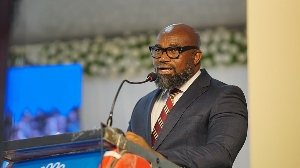General News of Monday, 8 December 2003
Source: GNA
Japan installs observatory in Ghana
In pursuit of science education in Ghana, a consortium of science universities in Japan, in collaboration with the Ghana Education Service (GES) have installed an Internet Astronomical Observatory at the Tema Secondary School (TEMASCO).
The 150,000 dollar project was installed at the roof-top of the Administration block of the school to fall in line with the Greenwich Meridian Line on which the school is located. Known as I-Observatory with an ordinary internet telescope, the objective is primarily to acquire high quality images available on CD-ROMs and on the internet.
Prof. Takehiko Satoh, Associate Professor, Faculty of Education, Kumamoto University installed the equipment and handed it over to Mrs Lucy Kwapong, Tema Municipal Director of Education at a brief but impressive ceremony at TEMASCO.
He explained that the I-Observatory would be an interactive, user-operable, remote-control system with which the users could get not only images, but also experience real astronomical observations. A consortium of science universities in Japan, including Kumamoto, Shinshu, Chiba and Keio Senior High Schools, in collaboration with the GES and Japan International Co-operation Agency (JICA) decided to install the equipment for the “ASOBI” project under the Ghana-Japan collaboration in science education with I-Observatories.
Prof. Satoh said the equipment of the I-Observatory, which was cleared from the Tema harbour last Wednesday was an educational tool of Internet Technology (IT), which was “astronomical observatory” (ASOB-I) on the internet, and was one of the essentials for effective learning in science.
He explained that an I-Observatory could be placed anywhere in the world as long as it was connected via the internet, however, the most interesting place to build such a system was on the opposite (relative to the user) side of the earth, with half a day of time difference, so that true night sky could be viewed at classes during day time.
Prof. Satoh pointed out that, since Ghana is located on the Prime Meridian, and there exists nine hours time difference with Japan (it is about midnight in Ghana when classes begin in the morning in Japan) Japanese students may be able to study astronomical subjects with true experiences utilising the I-Observatory in Ghana and the same applies to Ghanaian students.
The Professor noted that as a populated city, Tema is the closest to the crossing of the prime meridian and the equator, adding this geographical peculiarity could help increase students’ interests in location of the I-Observatory from which the starry sky was broadcast to their classes via the internet.
He disclosed that the cost of the internet system for the project was estimated at 800 dollars a month and this would be absorbed by the consortium of science universities in Japan, initially for two years and could be extended to a five - year period when the equipment would have to be changed for a more efficient one.
Mrs Kwapong expressed gratitude to Prof. Satoh and the consortium of science universities in Japan who made the project, which, “we saw as a dream” possible.
She said I-observatory was first announced when Prof. Satoh who visited Ghana, addressed the Science, Technology and Mathematics Education (STME) for girls and boys drawn from JSS and SSS in the Tema Municipality in late August this year.
Mrs Kwapong was hopeful that the project would benefit all students in Ghana, especially those in Tema.
Mrs Eunice Quansah, Headmistress of the school gave the assurance that the facility would be opened to students from far and near to enhance the teaching of science.
Those present were made to view the sky with the moon, which was then in thick clouds and some stars.
Among those present were Madam Razuko Asai, Japanese Ambassador, some members of the Board of Governors of the school, members of staff and Mr George K. Scot, co-ordinating director of the Tema Municipal Assembly and Executive members of JICA. GNA










